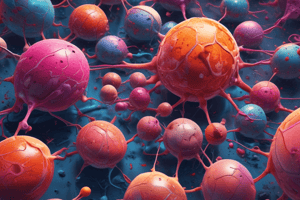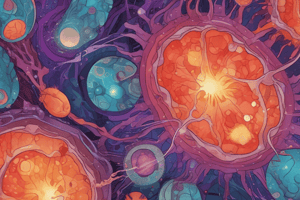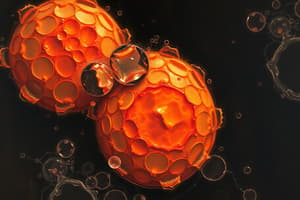Podcast
Questions and Answers
What is the process tightly regulated by an intracellular program involving the activation of enzymes that degrade the cell's own DNA and proteins?
What is the process tightly regulated by an intracellular program involving the activation of enzymes that degrade the cell's own DNA and proteins?
- Neoplasia
- Necrosis
- Apoptosis (correct)
- Atrophy
Which characteristic is NOT associated with apoptotic cells?
Which characteristic is NOT associated with apoptotic cells?
- Fragmentation of DNA
- Loss of mitochondrial function
- Nucleus enlargement (correct)
- Degradation of the cytoskeletal framework
In a pathological event such as viral infection, what is the purpose of apoptosis?
In a pathological event such as viral infection, what is the purpose of apoptosis?
- To eliminate unwanted or potentially harmful cells (correct)
- To promote mitochondrial function
- To induce phagocytosis
- To cause cell enlargement
What does excessive apoptosis result in?
What does excessive apoptosis result in?
Which type of necrosis is characteristic of focal bacterial infections?
Which type of necrosis is characteristic of focal bacterial infections?
What is the defining feature of coagulative necrosis in the kidney?
What is the defining feature of coagulative necrosis in the kidney?
In which condition does fat necrosis typically occur?
In which condition does fat necrosis typically occur?
What distinguishes caseous necrosis in tuberculous infections?
What distinguishes caseous necrosis in tuberculous infections?
What is apoptosis (programmed cell death)?
What is apoptosis (programmed cell death)?
What results in the formation of creamy yellow pus in necrotic tissue?
What results in the formation of creamy yellow pus in necrotic tissue?
What are the early functional changes in reversible cell injury?
What are the early functional changes in reversible cell injury?
What are the ultrastructural changes associated with reversible cell injury?
What are the ultrastructural changes associated with reversible cell injury?
What are the morphological changes associated with irreversible injury?
What are the morphological changes associated with irreversible injury?
What is necrosis in terms of cellular or tissue death?
What is necrosis in terms of cellular or tissue death?
Which form of necrosis is characteristic of hypoxic death of cells in all tissues except the brain?
Which form of necrosis is characteristic of hypoxic death of cells in all tissues except the brain?
What does apoptosis refer to?
What does apoptosis refer to?
Coagulative necrosis results in the transformation of tissue into a liquid viscous mass.
Coagulative necrosis results in the transformation of tissue into a liquid viscous mass.
Liquefactive necrosis is characteristic of focal bacterial infections.
Liquefactive necrosis is characteristic of focal bacterial infections.
Caseous necrosis is most often found in foci of parasitic infections.
Caseous necrosis is most often found in foci of parasitic infections.
Fat necrosis typically occurs in acute pancreatitis due to the release of activated pancreatic lipases.
Fat necrosis typically occurs in acute pancreatitis due to the release of activated pancreatic lipases.
Apoptosis is a form of cellular growth control that contributes to cell accumulation.
Apoptosis is a form of cellular growth control that contributes to cell accumulation.
Reversible and irreversible cell injury can both lead to morphological changes associated with necrosis.
Reversible and irreversible cell injury can both lead to morphological changes associated with necrosis.
Apoptosis is tightly regulated by an extracellular program.
Apoptosis is tightly regulated by an extracellular program.
Apoptotic cells retain an intact plasma membrane, facilitating phagocytosis.
Apoptotic cells retain an intact plasma membrane, facilitating phagocytosis.
Necrosis and apoptosis both involve the fragmentation of DNA.
Necrosis and apoptosis both involve the fragmentation of DNA.
Apoptosis is primarily triggered to eliminate irreversibly damaged cells in pathological events such as radiation and viral infection.
Apoptosis is primarily triggered to eliminate irreversibly damaged cells in pathological events such as radiation and viral infection.
Reversible cell injury is characterized by extensive damage to all cellular membranes.
Reversible cell injury is characterized by extensive damage to all cellular membranes.
The morphology of reversible cell injury includes vacuolated mitochondria.
The morphology of reversible cell injury includes vacuolated mitochondria.
Necrosis refers to physiological cellular or tissue death in a living organism, irrespective of cause.
Necrosis refers to physiological cellular or tissue death in a living organism, irrespective of cause.
Caseous necrosis is characteristic of hypoxic death of cells in all tissues except the brain.
Caseous necrosis is characteristic of hypoxic death of cells in all tissues except the brain.
Liquefactive necrosis is the most common form of necrosis.
Liquefactive necrosis is the most common form of necrosis.
Fat necrosis typically occurs in conditions such as viral infection.
Fat necrosis typically occurs in conditions such as viral infection.
Flashcards are hidden until you start studying
Study Notes
- Cell injury, apoptosis & death - II: A topic covering reversible and irreversible injury, morphology of cell injury and necrosis, and apoptosis.
- Reversible injury: Early functional changes include decreased ATP generation, loss of cell membrane integrity, defects in protein synthesis, and cytoskeletal and DNA damage. Morphological changes include cellular swelling, plasma membrane alterations, mitochondrial swelling, and nuclear alterations.
- Irreversible injury (necrosis): Extensive damage to all cellular membranes, swelling of lysosomes and mitochondria, extracellular calcium entry, intracellular calcium release, activation of enzymes that catabolize membranes, proteins, ATP, and nucleic acids, and nuclear changes (pyknosis, karyorrhexis, and karyolysis).
- Different types of necrosis: Coagulative, liquefactive, caseous, and fat necrosis. Each type is characterized by specific morphologic changes and is seen in different tissues.
- Apoptosis (programmed cell death): An individual cell deletion process in physiological growth control and disease. Activated or prevented by various stimuli, with reduced apoptosis contributing to cell accumulation (e.g., neoplasia) and increased apoptosis resulting in excessive cell loss (e.g., atrophy).
- Tightly regulated by intracellular program, apoptosis involves pro-apoptotic cells activating enzymes that degrade the cell's own DNA and proteins. In normal situations, it eliminates unwanted or potentially harmful cells. In pathological events, it eliminates irreversibly damaged cells, particularly when the damage affects the cell's DNA.
- Characteristics of apoptotic cells: Degradation of the cytoskeletal framework, fragmentation of DNA, loss of mitochondrial function, nucleus shrinkage (pyknosis) and fragmentation (karyorrhexis), and cell shrinkage with an intact plasma membrane.
- In a case study, a patient with stroke symptoms underwent a CT scan showing cerebral infarction. Ten days after the onset of symptoms, the patient died, and an autopsy was performed. The pathologist is most likely to observe irreversible injury (necrosis) in the brain due to the prolonged duration since the onset of symptoms.
Studying That Suits You
Use AI to generate personalized quizzes and flashcards to suit your learning preferences.




